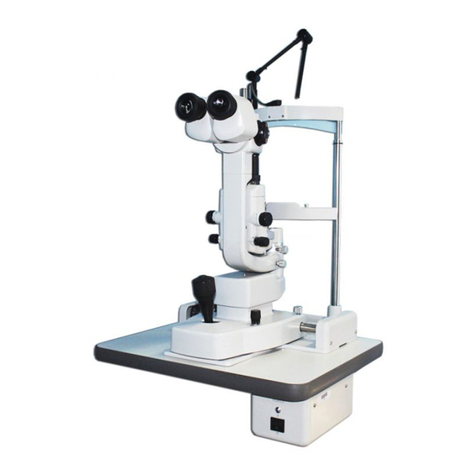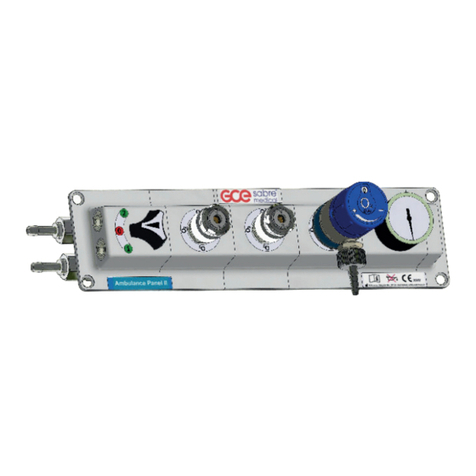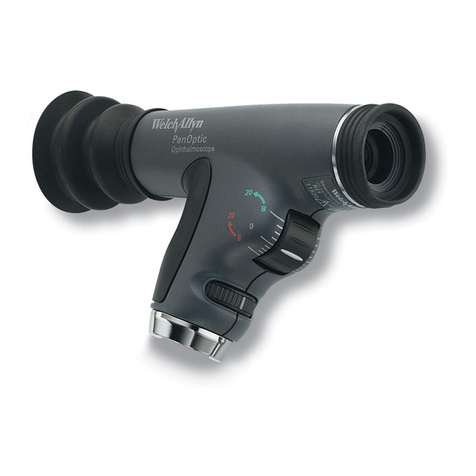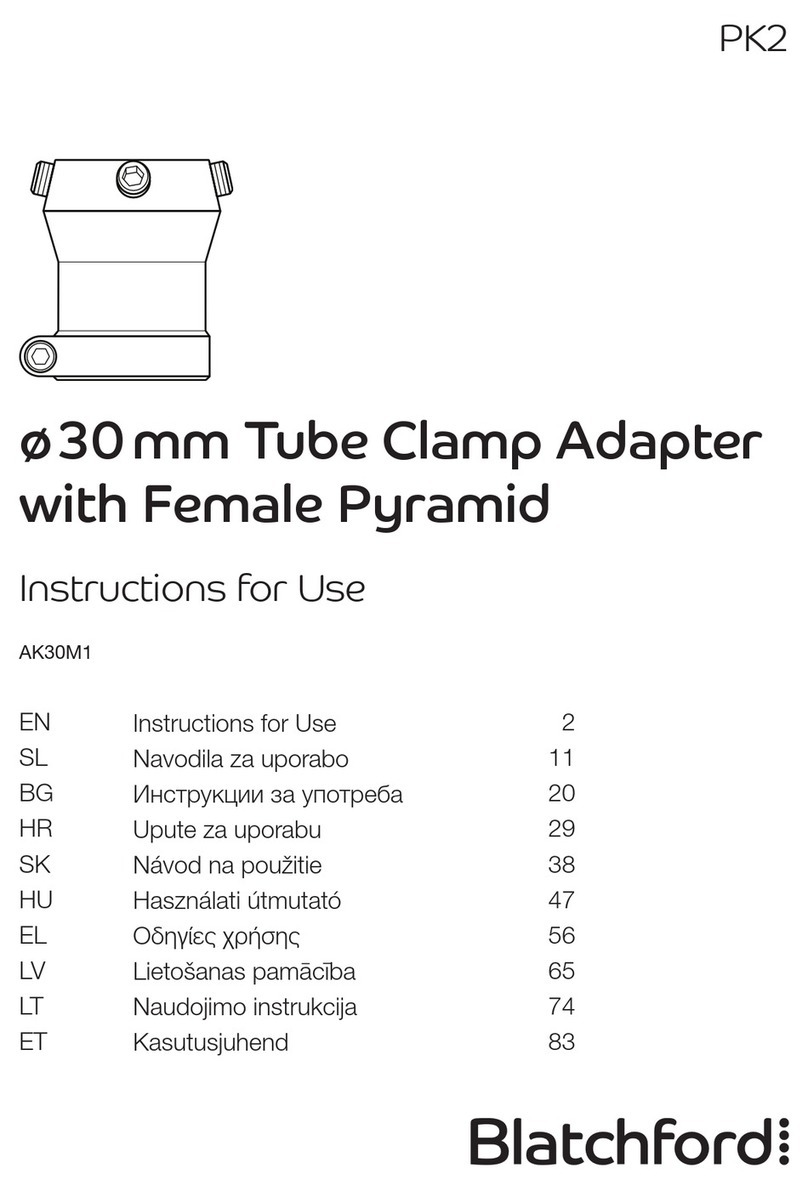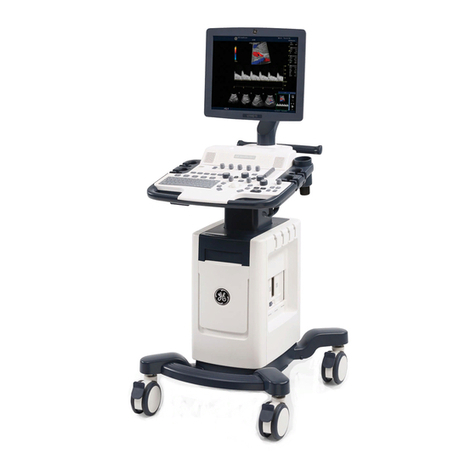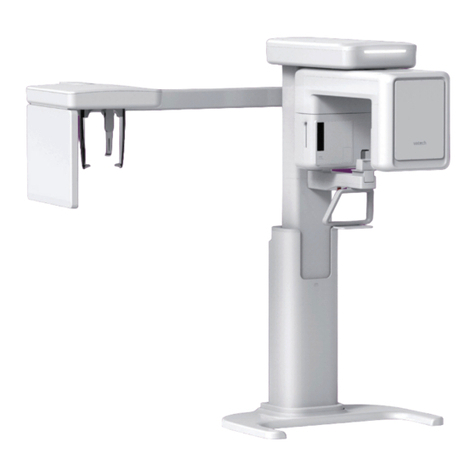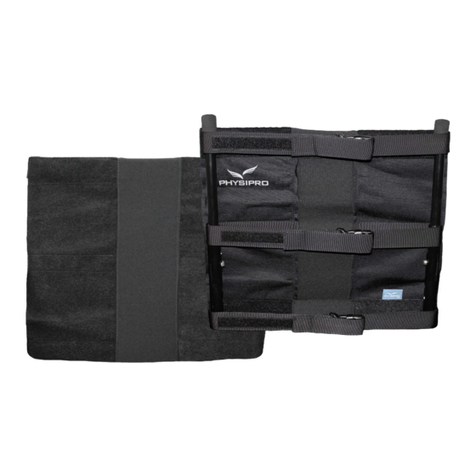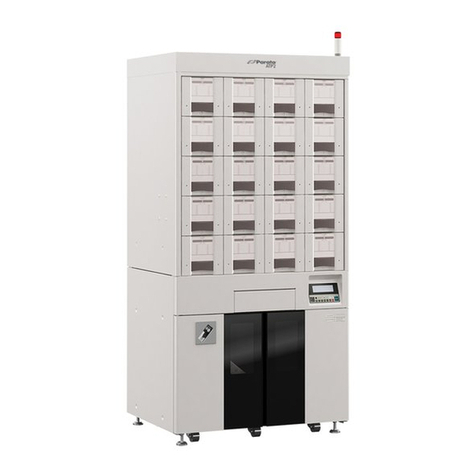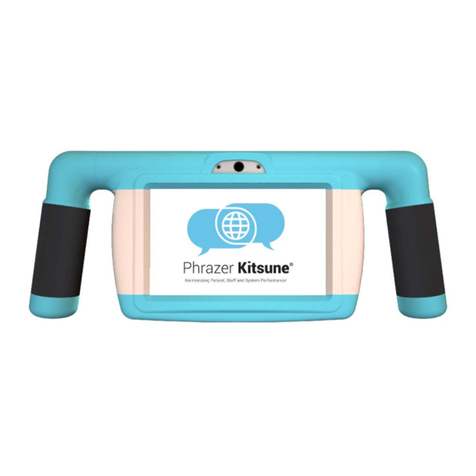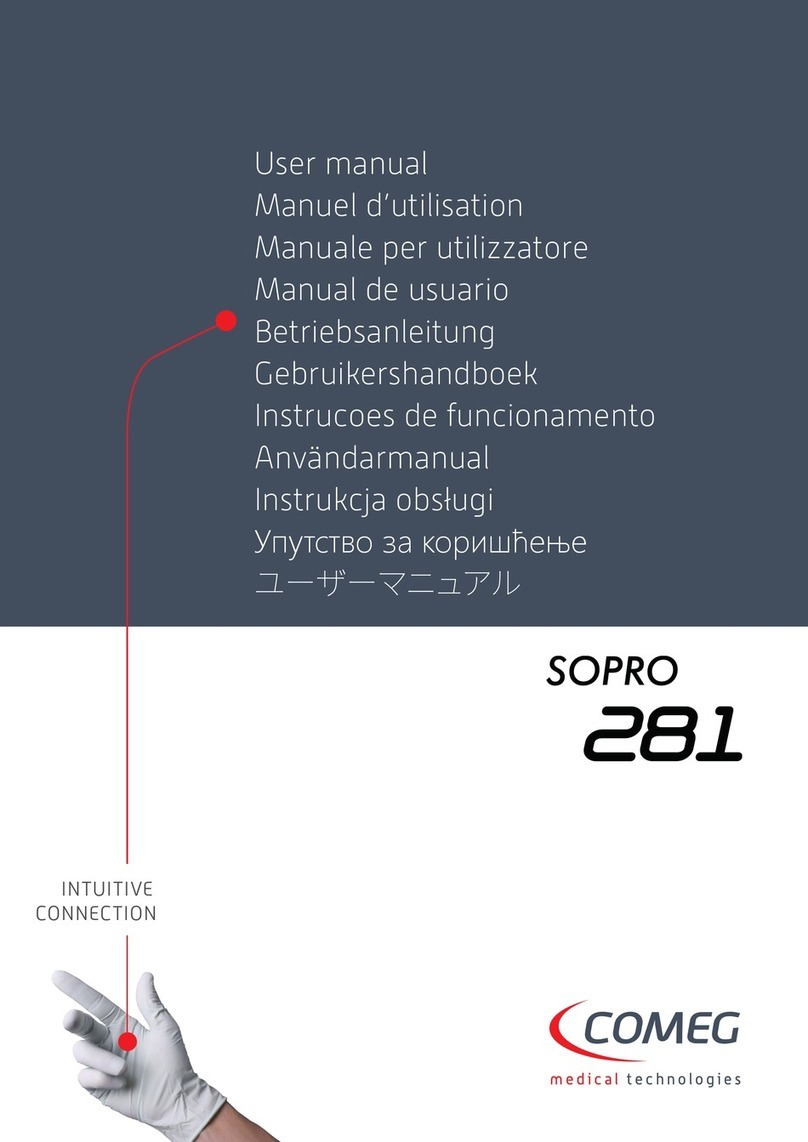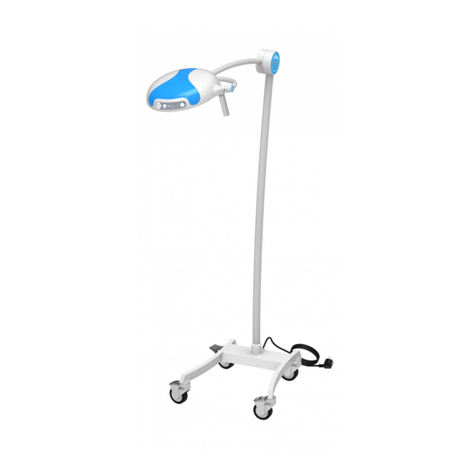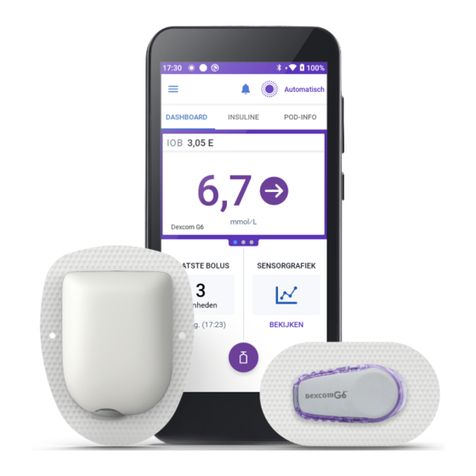tricog Vcardia VC100 User manual

USER
MANUAL
Accelerang Cardiac Care
VC100

Accelerang Cardiac Care
Vcardia VC100 User Manual Rev 01
Table of Contents
Content Page
1. Introduction
3
1.1. About the manual 3
1.1.1. Purpose 3
1.1.2. Intended user
3
1.1.3. Contraindications 3
1.2. Safety Information 4
1.2.1. Note 5
1.2.2. Applicable Warning and Caution 5
1.2.3. Environmental Requirements
6
1.2.4. Warnings 6
2. Intended Use 7
3. Device Description
7
3.1. Main Unit 7
3.1.1. Views 8
3.1.2. Display screen 9
3.2. Modes of Operation 10
3.3. Parts and Accessory Devices
11
4. Setting up the Equipment 11
4.1. Unpacking and Checking 11
4.2. Installation Instructions
12
4.3. Getting Started 12
4.3.1. Connecting the device 12
4.3.2. Connecting Lead Wires and Electrodes
15

Accelerang Cardiac Care
Vcardia VC100 User Manual Rev 01
4.3.2.1. Chest Electrode 15
4.3.2.2. Limb Electrode 16
4.3.2.3. Connecting Chest Lead Wires with Chest Electrodes 16
4.3.2.4. Connecting Limb Lead Wires with Limb Electrodes 16
Lead wire colour code 17
4.3.3. Connecting Patient Cable 17
4.3.4. Turning on/off the equipment 18
4.3.5. Configuring the VCardia unit 19
5. Skin Preparation and Lead Placement 19
5.1. Preparing the Skin 20
5.2. Applying Electrodes 20
5.2.1. Electrode Placement 20
5.2.2. Applying Reusable Electrodes 21
5.2.2.1. Applying Limb Electrodes 21
5.2.2.2. Applying Chest Electrodes 21
5.2.3. Applying Disposable Electrodes 22
6. ECG Capture 22
7. ECG Results and Report 28
7.1.1. Global ECG measurements: 28
7.2. ECG Report 30
7.2.1. Printing the ECG report
30
7.2.2. Sharing the ECG Report 31
7.2.3. Saving the ECG Report 32
8. Settings option 33
9. Troubleshooting 35
9.1. General Troubleshooting 35
9.2. Specific Issues 36

Accelerang Cardiac Care
Vcardia VC100 User Manual Rev 01
9.2.1. Device does not power up 36
9.2.2. Unacceptable Noise in the ECG data. 36
10. Declaration 36
11. Maintenance 36
11.1. Device Maintenance 36
11.1.1. Regular Inspection 36
11.1.2. Cleaning and Disinfecting 37
Battery Maintenance 37
11.2. Cable Maintenance 37
11.3. Storage 37
11.3.1. Storage of device and accessories 37
12. Appendix 38
12.1. Product Specifications 38
12.1.1. Classifications 38
12.1.2. Environmental Specifications 39
12.1.3. Physical Specifications 39
12.1.4. Hardware Specifications 39
12.1.4.1. Display 39
12.1.4.2. Equipment Connector 39
12.1.5. System Specifications 39
12.1.6. Application specifications 39
12.1.7. Measurement Specifications 40
12.2. EMC & Radio Regulatory Compliance 42
12.2.1. EMC 42
12.2.2. Cable Information 47
12.3. Abbreviations and Symbols 48
12.3.1. Abbreviations and Definitions 48
12.3.2. Symbols 48
12.4. Potential Adverse Events 50

Accelerang Cardiac Care
Vcardia VC100 User Manual Rev 01
Tricog Confidential
All the material contained in this document is the property of Tricog Singapore and is confidenal
and protected by copyright laws and cannot be used, modified, reproduced, distributed or in any
way exploited in whole or in part thereof for any purpose without the expressed wrien consent
of Tricog Singapore - Director. No part of this document may be used for purposes other than that
intended by Tricog. Copyright 2023 Tricog© All rights reserved. Tricog® is a registered trademark
of Tricog Health PTE. LTD.
Copyright 2023 Tricog© All rights reserved. Tricog® is a registered trademark of Tricog Health PTE. LTD.
Company Contacts
A printable version of this user guide can be obtained by
contacng support@tricog.com
Manufactured at
TRICOG HEALTH (INDIA) PVT. LTD.
A unit of TRICOG HEALTH PTE. LTD.
Old No. 82, New No. 3, PID No. 5-24-3, 2nd Main Road,
Vyalikaval Extension, Malleshwaram,
Bengaluru, Karnataka, India, 560003
Support and Safety
Email: support@tricog.com
Website
www.tricog.com

Accelerang Cardiac Care
Vcardia VC100 User Manual Rev 01
Responsibility on the Manufacturer Party
Contents of this manual are subject to changes without prior notice.
All information contained in this manual is believed to be correct. Tricog shall not be liable for
errors contained herein nor for incidental or consequential damages in connection with the
furnishing, performance, or use of this manual.
Tricog is responsible for the effects on safety, reliability and performance of this product,
only if:
• All installation operations, expansions, changes, modifications and repairs of this product
are conducted by Tricog authorised personnel;
• The electrical installation of the relevant room complies with the applicable national and
local requirements;
• The product is used in accordance with the instructions for use.
Warning
• This equipment must be operated by skilled/trained clinical professionals.
• It is important for the hospital or organisation that employs this equipment to carry out a
reasonable service/maintenance plan. Neglect of this may result in machine breakdown
or personal injury.
Warranty
This Warranty Is Exclusive And Is In Lieu Of All Other Warranties, Expressed Or Implied,
Including Warranties Of Merchantability Or Fitness For Any Particular Purpose.
Exemptions
• Tricog's obligation or liability under this warranty does not include any transportation or
other charges or liability for direct, indirect or consequential damages or delay resulting
from the improper use or application of the product or the use of parts or accessories not
approved by Tricog or repairs by people other than Tricog authorised personnel.
This warranty shall not extend to
• Malfunction or damage caused by improper use or man-made failure.
• Malfunction or damage caused by unstable or out-of-range power input.
• Malfunction or damage caused by force majeure such as fire and earthquake.
• Malfunction or damage caused by improper operation or repair by unqualified or
unauthorised service people.
• Malfunction of the instrument or part whose serial number is not legible enough.
• Others not caused by the instrument or part itself.

1. Introduction
VCardia VC100 (VCardia) is an android based ECG machine which is built to give the
experience of mobility to capture ECG in any clinical or non-clinical setup.
1.1. About the manual
1.1.1. Purpose
The purpose of this manual is to provide the user with information about VCardia VC100,
android mobile application (ver-8.0.0) and the necessary instructions to use the device,
capture the ECG and to acquire the captured ECG. This manual is an integral part of the
product. It should always be kept close to the equipment so that it can be referred to as
per requirement.
1.1.2. Intended user
This manual is intended to be used by clinical professionals or technicians who use and
maintain VCardia. The personnel is expected to have corresponding working knowledge
of medical procedures, practices and terminologies used in the treatment of patients.
1.1.3. Contraindications
• VCardia is not intended for use during patient transportation.
• VCardia is not intended for use in home healthcare and ambulances.
• VCardia is not intended for intracardiac application.
• VCardia is not intended for use with high frequency surgical units or devices.
• The display will be blank in the presence of a high amplitude pulse i.e 250 mV and
greater.
• VCardia is not intended for use as a vital signs monitor.
Accelerang Cardiac Care
Vcardia VC100 User Manual Rev 01
Page 3 of 52

Accelerang Cardiac Care
Vcardia VC100 User Manual Rev 01
Symbol Title of the symbol Description of symbol
Caution
Indicates the need for the user to consult the instructions for use
for important cautionary information such as warnings and
precautions that cannot, for a variety of reasons, be presented on
the medical device itself.
Warning Indicates a potential hazard, obstacle, or condition requiring
special attention.
1.2. Safety Information
Familiarise yourself with these warnings. Specific warnings and cautions are given
throughout this manual.
Page 4 of 52

Accelerang Cardiac Care
Vcardia VC100 User Manual Rev 01
Symbol Message
A
ll leads should be connected and all the electrodes must be applied to the correct sites.
T
he conductive parts of the patient cable and electrodes, including the neutral electrode, should not
c
ontact other conductive parts, including earth.
A
fter defibrillation, a residual charge may be retained by polarising electrodes which may block the
a
cquisition of the ECG signal.
D
isposable electrodes must never be reused. Reusing disposable electrodes may cause inaccurate
m
easurements or contamination
T
o avoid the risk of electric shock, use the manufacturer specified defibrillation proof ECG cable lead
w
ires and electrodes.
N
ickel present in the reusable electrodes may cause skin irritation. Monitor the electrode site and use
a
n alternative electrode in case of skin irritation.
T
his equipment must not be used with high frequency surgical units.
U
sers must not be in contact with patients during defibrillation as it could cause serious injury or even
d
eath.
T
he equipment may mistake a pace pulse for a QRS complex if several adverse conditions exist
s
imultaneously. The paced patients must always be under surveillance.
R
oute all cables properly to prevent a stumbling hazard and to avoid inadvertent disconnection. Wrap
t
he excess part to reduce entanglement or strangulation.
A
uto measurements/diagnoses cannot be used for patient treatment as they are only for reference.
T
he latex in the bulb of the metal electrode may cause skin irritation. Monitor the electrode site and use
a
n alternative electrode in case skin irritation occurs.
A
ll reusable electrodes must be cleaned and disinfected before applying on the patient.
P
atient electrode types or brands must never be mixed. Baseline drift will be caused due to dissimilarity
i
n metals or due to other incompatibilities, increasing the trace recovery after defibrillation
1.2.1. Note
Provides additional useful information to understand the equipment better.
1.2.2. Applicable Warning and Caution
Page 5 of 52

Accelerang Cardiac Care
Vcardia VC100 User Manual Rev 01
1.2.3. Environmental Requirements
The equipment is suitable for use in the patient environment. The operating environment of the
equipment must meet the requirements specified in this manual. The equipment operating
environment should be reasonably free from noises, vibration, dust, corrosive, flammable and explosive
substances. If the equipment is installed in a cabinet, sufficient space in front and behind should be left
for convenient operation, maintenance and repair. Moreover, to maintain good ventilation, the
equipment should be at least 5 cm away from around the cabinet. When the equipment is moved from
one place to another, condensation may occur as a result of temperature or humidity difference. In this
case, never start the system before the condensation disappears.
1.2.4. Warnings
Make sure that the operating environment of the equipment meets the specific requirements.
Otherwise unexpected consequences, e.g. damage to the equipment, could result. To avoid explosion
hazard, do not use the equipment in the presence of oxygen-rich atmospheres, flammable
anaesthetics, or other flammable agents, such as gasoline. Magnetic and electrical fields are capable
of interfering with the proper performance of the equipment. For this reason make sure that all external
devices operated in the vicinity of the equipment comply with the relevant EMC requirements. Mobile
phones, X-ray equipment or MRI devices are a possible source of interference as they may emit higher
levels of electromagnetic radiation. The mains plug is used to isolate the equipment circuits electrically
from the SUPPLY MAINS. Do not position the equipment so that it is difficult to operate the plug. Before
connecting the equipment to the power line, check that the voltage and frequency ratings of the power
line are the same as those indicated on the equipment’s label or in this manual.
Note:
Put the equipment in a location where you can easily see the screen and access the operating
controls.
Keep this manual in the vicinity of the equipment so that it can be conveniently referenced when
needed.
Page 6 of 52

Accelerang Cardiac Care
Vcardia VC100 User Manual Rev 01
2. Intended Use
VCardia VC100 is designed to be a clinical-grade Resting Electrocardiograph intended to capture 12
Lead Electrocardiograms (ECG) with the support of an Android app connected to an Android
smartphone via a USB cable. The machine should be used with approved accessories including
standard ECG cables and gel. VC100 is intended to be used in clinical environments by trained
medical practitioners to detect cardiac abnormalities in adults. Electrocardiograms should always
be overread by qualified physicians and are not intended to be the sole criteria for diagnosis and
treatment of the patient.
3. Device Description
The VCardia 12 Lead Resting Electrocardiograph is connected to the patient's body with 4 limb
electrodes and 6 chest electrodes which are securely connected to the VCardia unit with a cable that
terminates into a DB-15 connector. A trained medical practitioner makes the patient ready by making
him lie down on a flat-bed, shave hair (if required) near the contact positions, and also apply the
conductive gel at the electrode contact positions.
The practitioner connects the Android device to the VCardia unit with a Micro USB/Type C USB cable
(OTG). Once connected, the VCardia unit is now ready to capture ECG. The workflow is triggered by the
VCardia smartphone application. The medical practitioner enters patient details and captures the
resting ECG.
Fig. 1: VCardia VC100
3.1. Main Unit
Page 7 of 52

Accelerang Cardiac Care
Vcardia VC100 User Manual Rev 01
3.1.1. Views
Fig. 2.: Top View, Left View and Right View
Page 8 of 52

Accelerang Cardiac Care
Vcardia VC100 User Manual Rev 01
3.1.2. Display screen
Fig. 3.: Display Screen
Patient Info
ECG Lead
Signal Settings
Page 9 of 52

Accelerang Cardiac Care
Vcardia VC100 User Manual Rev 01
3.2. Modes of Operation
The devices operates in two modes:
Active Mode (Default)
Demo Mode
Fig. 4.: Display
Screen (Active mode)
Fig. 5.: Display
Screen (Demo mode)
Active Mode allows the user to capture an ECG from the patients, whereas, in the Demo mode, a
simulated ECG graph will be shown which is used for demo only.
Page 10 of 52

Accelerang Cardiac Care
Vcardia VC100 User Manual Rev 01
3.3. Parts and Accessory Devices
The following are the accessories of the device:
• Android 7.0+ mobile phone
• OTG USB cables (Type-C and Micro-USB)
• Patient lead cables
• Gel
• Clamp and bulb electrodes
Item name Quantity
VCardia VC100 unit 1
12 Lead Cables
1
Gel Bottle
1
OTG USBcables
(Type - C and Micro-USB)
2
Clamp Electrodes
4
Bulb electrodes
6
The above mentioned units are unpacked from the box and the
cables are connected to the VCardia unit.
Fig. 6.: Components
4. Setting up the Equipment
4.1. Unpacking and Checking
The unit is dispatched with the following components which are received with the package:
Clamp
Electrodes
Bulb
Electrodes
Patient
Cable
OTG
Cable
Page 11 of 52

Accelerang Cardiac Care
Vcardia VC100 User Manual Rev 01
4.2. Installation Instructions
Ensure that the mobile android version is 7.0+ with OTG support.
4.3. Getting Started
4.3.1. Connecting the device
Communication with the VCardia unit is enabled through the OTG (On-The-Go) option on the
mobile phone where it enables the VCardia unit to transfer data to the phone.
A slot for holding the mobile phone is provided as seen in the figure.7 Secure the mobile phone into
the slot and follow the steps below.
Slot for Mobile Phone
Keypad
ECG Capture Button
Fig. 7.: Mobile phone slot, keypad and ECG capture button on the device
Page 12 of 52

Accelerang Cardiac Care
Vcardia VC100 User Manual Rev 01
Step 1: On the right side of the unit, you can find the Mini-USB port and a switch.
USB Port
Device ON/OFF Switch
Mini USB port for Mobile
phone interface
Fig. 8.: Ports and ON/OFF switch
Step 2: There are two different types of cables included depending on the USB
connection required to be connected to the phone.
a. For smartphones with a micro USB
connector use the provided mini USB
connector to micro USB cable as
shown in the picture.
Fig. 9.: Mini USB
connector (Micro USB)
b. For smartphones with a type-C USB
connector use the provided mini USB
connector to type C USB cable as
shown in the picture
Fig. 10.: Mini USB connector (Type C)
Page 13 of 52

Accelerang Cardiac Care
Vcardia VC100 User Manual Rev 01
Fig. 11.: USB connector connected to device
Step 3: Connect the smartphone with the VCardia unit
a. Use the correct USB cable as mentioned in the previous step.
b. Connect the mini USB to the VCardia unit mini USB port present at the right-side panel of the
device as shown in the image below.
c. Connect the other end to the smartphone USB port.
USB Port
Device ON/OFF Switch
Mini USB port for Mobile
phone interface
Fig. 12.: Mini USB connected to device
Fig. 13.: Mini USB connected to phone and VCardia
Turning On the OTG settings on the smartphone
a. Some smartphones provide extra settings to turn ON and OFF the OTG settings.
b. If required, enable the OTG option in the Android System Settings.
Page 14 of 52

Accelerang Cardiac Care
Vcardia VC100 User Manual Rev 01
4.3.2. Connecting Lead Wires and Electrodes
Take the patient cable, bulbs and clamps out. The patient cable consists of a connector, a trunk cable, 4
limb lead wires and 6 chest lead wires. All the lead wires are colour coded. The connector cable connects
to the ECG, the limb wires connect the limb electrodes and the chest lead wires connect the chest
electrodes.
Fig. 18.: Patient Cable
1. Bulb
2. Trunk cable
3. Limb lead wires
4. Chest lead wires
4.3.2.1. Chest Electrode
The chest electrode is made of a bulb and a metal electrode. Two lead wire connectors are present on
the metal electrode, one for lead wire with Ф3.0 mm connector, and another for lead wire with Ф4.0 mm
connector.
Fig. 19.: Chest electrode
1. Bulb
2. Lead wire connector
3. Lead wire connector
4. Chest lead wires
Page 15 of 52

Accelerang Cardiac Care
Vcardia VC100 User Manual Rev 01
4.3.2.2. Limb Electrode
The limb electrode consits of a plastic clamp and a metal electrode. There are two lead wire
connectors present on the metal electrode one for lead wire with Ф3.0 mm connector, and another
for lead wire with Ф4.0 mm connector.
Fig. 20.: Limb electrode
1. Lead Wire connectors
2. Metal electrodes
3. Clamp
4.3.2.3. Connecting Chest Lead Wires with Chest Electrodes
• Plug the chest and the lead wires into the lead wire connectors of the 6 electrodes based on
the lead wire colour code table below.
• Adjust each lead wire such that the electrode and the lead wire come into proper contact.
4.3.2.4. Connecting Limb Lead Wires with Limb Electrodes
• Plug the limb lead wires into the lead wire connectors of the limb electrodes based on the lead
wire colour code table below.
• Adjust each lead wire such that the electrode and the lead wire come into proper contact.
Page 16 of 52
Popular Medical Equipment manuals by other brands
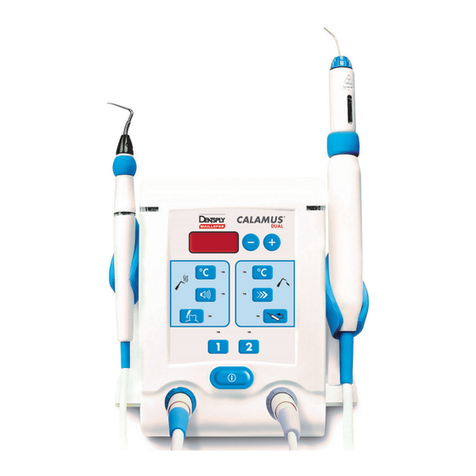
Dentsply Sirona
Dentsply Sirona Calamus Dual A1300 Directions for use
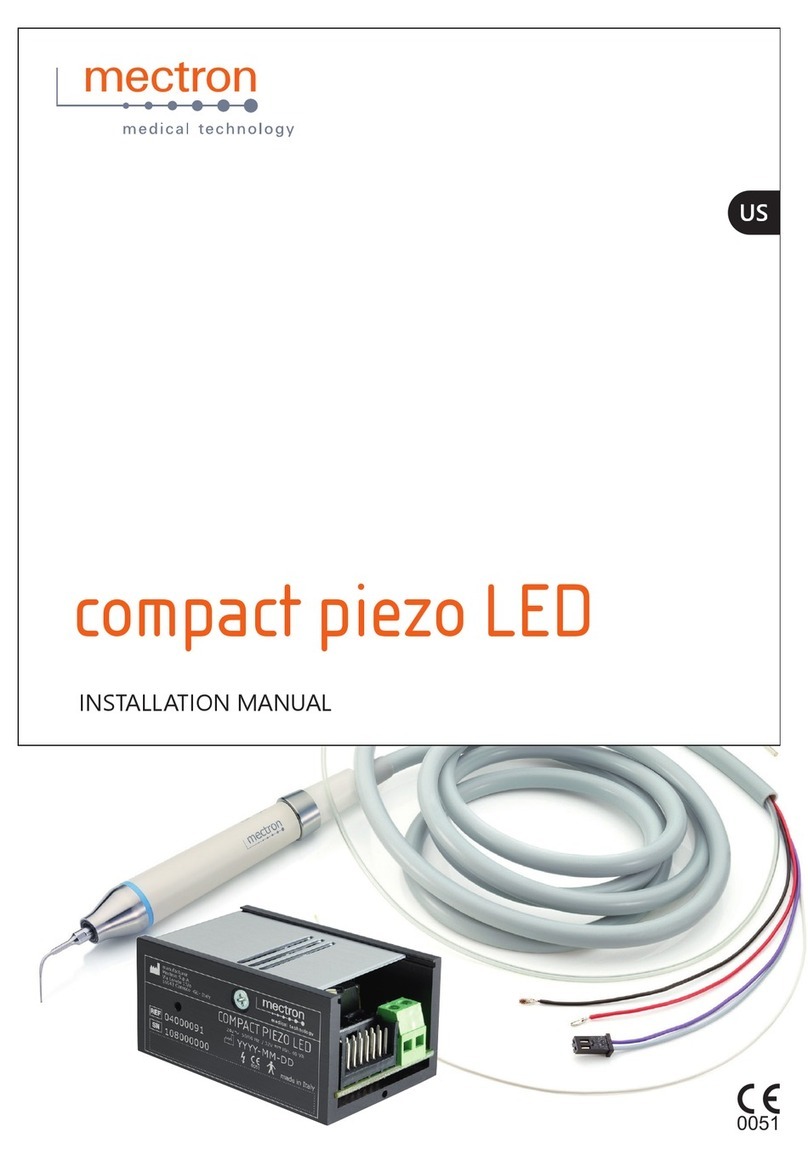
mectron
mectron COMPACT PIEZO LED installation manual
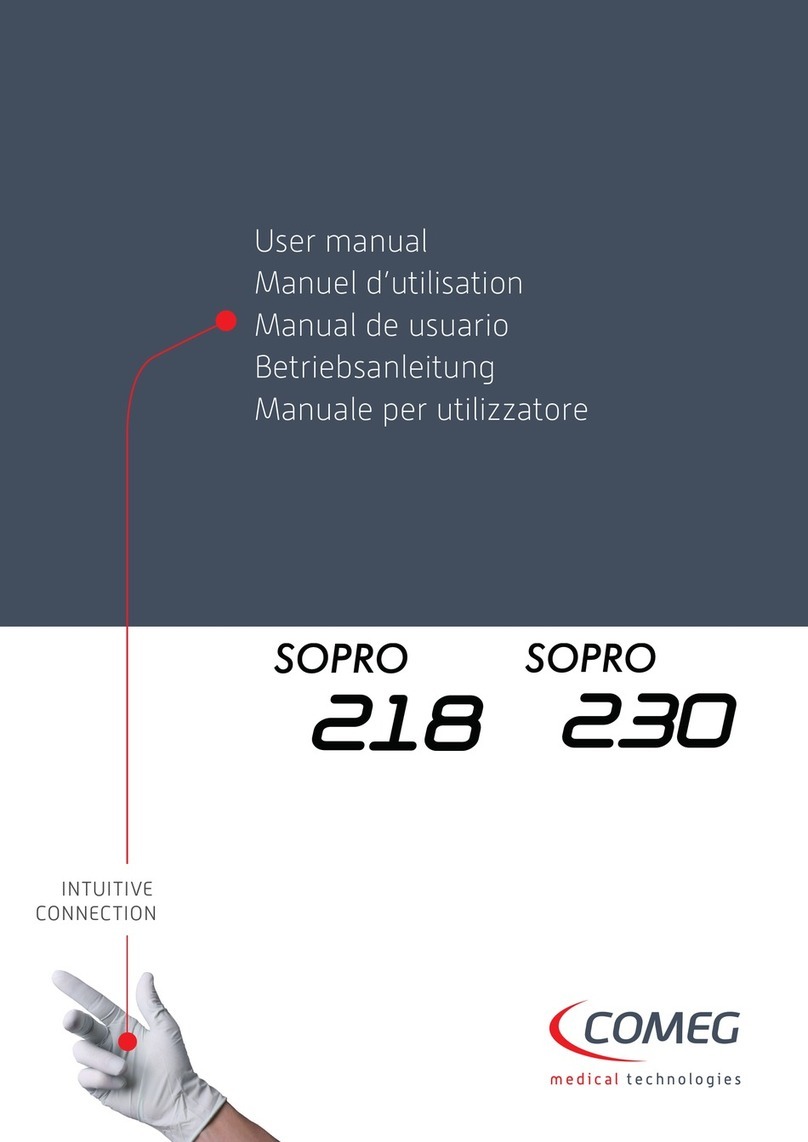
Comeg
Comeg SOPRO 218 user manual
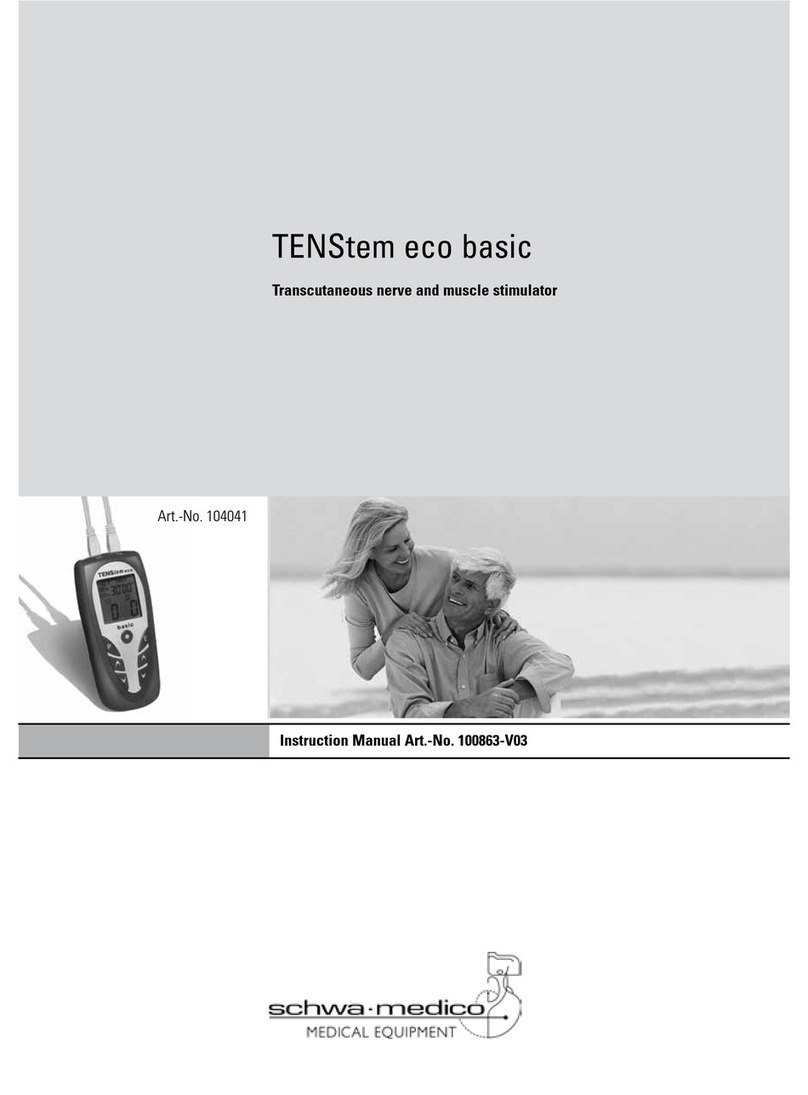
schwa-medico
schwa-medico TENStem eco basic 104041 instruction manual
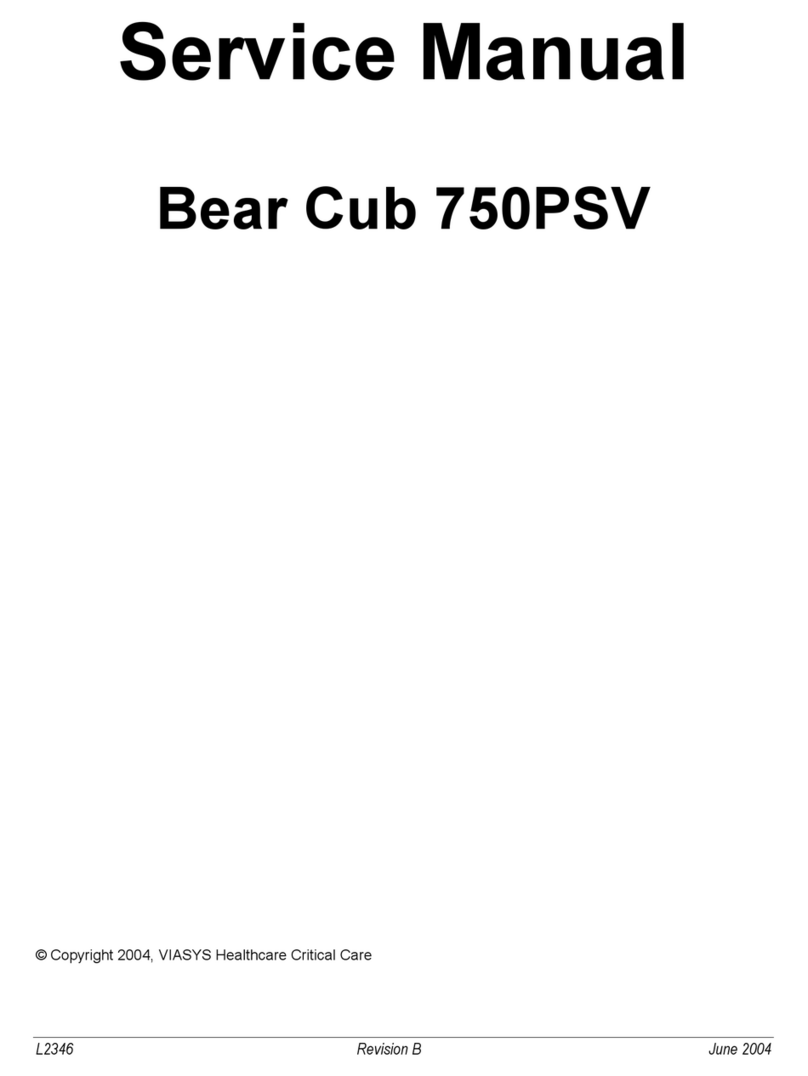
VIASYS
VIASYS Bear Cub 750PSV Service manual
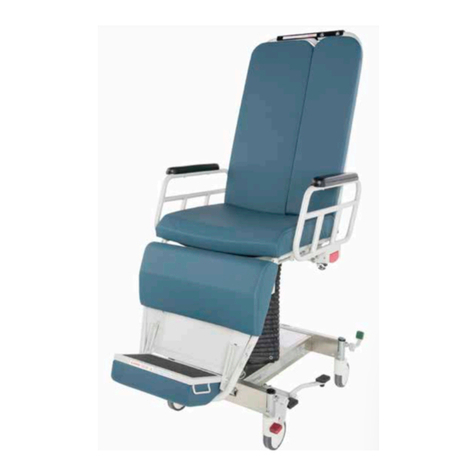
Graham Field
Graham Field Hausted VIC429 operating manual
